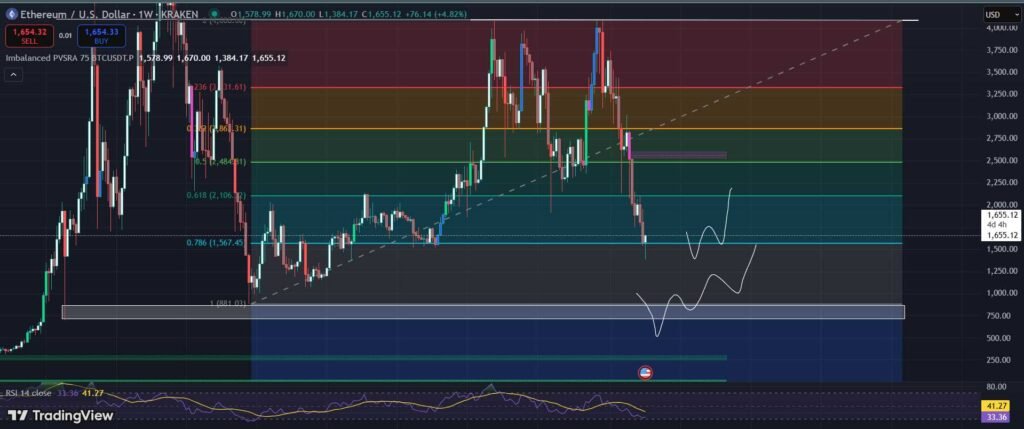Bitcoin Dominance (BTC.D) is one of the most crucial indicators for understanding the state of the cryptocurrency market. History shows us that when BTC.D reaches very high levels, it often signifies either that investors are flocking to Bitcoin as a “safe haven” or that we are nearing the peak of a bull run.

As of April 2025, the current picture for BTC.D is the increasing dominance of Bitcoin. When Bitcoin Dominance surpasses the 55–65% mark, we often see it as a signal that the market may be approaching the peak of a bull run. Bitcoin is absorbing a large portion of the market share, with investors moving away from altcoins and gravitating towards the largest and safest cryptocurrency.
When Does Bitcoin Dominance Indicate “Peak”?
Some signals we usually observe when BTC.D reaches high levels include:
- 📈 BTC.D surpasses 55-65%, indicating that investors are abandoning altcoins in favor of Bitcoin as a safe bet.
- 📉 Altcoins’ weakness, which start to show signs of underperformance.
- 🐋 On-chain data shows large holders (whales) liquidating substantial amounts of altcoins, opting instead for Bitcoin.
This suggests that we might be near the top for Bitcoin, and altcoins simply cannot keep pace with Bitcoin’s rise.
Ethereum: Its Role in the Market and the Contrast with Bitcoin
While Ethereum (ETH) once closely followed Bitcoin’s moves during bull runs, the current situation is quite different. Ethereum is no longer just considered Bitcoin’s “little brother,” as institutional investors have increasingly focused on ETH for various reasons.

Ethereum has evolved into one of the most powerful cryptocurrencies, with:
- Institutional Interest: Major financial institutions are increasingly turning to Ethereum due to its smart contract technology and its applications in the financial system.
- Ethereum 2.0 and PoS: The transition from Proof of Work (PoW) to Proof of Stake (PoS) has made Ethereum more environmentally friendly and more energy-efficient.
- Altcoin Nature: Despite its increasing utility, Ethereum is still considered a more risky asset (altcoin) compared to Bitcoin, as its price can be more volatile.
This means Ethereum is on a different trajectory than Bitcoin, which remains the “safe haven” for many investors in the cryptocurrency space.
Market Bottom: Are Cryptocurrencies Near Their Bottom?
With Bitcoin dominance on the rise and altcoins struggling, the next question is: Is the market near its bottom?
To determine this, we need to examine two key factors:
- The Relationship Between BTC.D and Altcoins: When BTC.D rises, altcoins tend to suffer. If Bitcoin’s market is approaching its peak, it’s likely that altcoins are at a bottom.
- On-Chain Analysis: Bitcoin and Ethereum’s movements can give us clues. If large companies are buying into Bitcoin or Ethereum at higher levels, it may suggest the market has reached a point of strong support.
This indicates that investors need to keep a close watch on the BTC/ETH ratio and track market trends carefully.
What Should Investors Do?
If you’re wondering how to position yourself in the market right now, follow these strategies:
- For New Investors: Don’t let the short-term hype drive your decisions. Consider a gradual investment in Bitcoin or Ethereum and avoid entering the market at the peak.
- For Active Traders: Short-positions on altcoins and long-positions on Bitcoin could be a viable strategy at this stage. Keep an eye on market signs to identify the right time to exit.
- For Long-Term Holders: If you’re already in profit, consider rebalancing your portfolio. Moving funds into stablecoins can help lock in profits while providing flexibility to buy back at lower prices if the market corrects.
The cryptocurrency market remains highly volatile, and trying to time the market is risky. Having a solid strategy—and access to reliable data—is crucial in navigating these uncertain times.
Conclusion: Peak or Market Bottom?
So, are we at the peak of the cycle, or is the market nearing its bottom? The data presents a mixed picture: While Bitcoin is showing strength with high dominance, alternatives like Ethereum have taken a more prominent role with growing institutional interest.
What is clear is that your strategy should be based on solid data and a long-term approach. Watch the risks, trends, and market analysis closely to make informed decisions.
At CryptoAnalyzes, we offer continuous analysis, portfolio management, and buying strategies to help you make the best decisions in the cryptocurrency market.




















